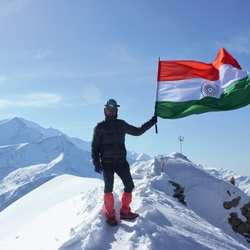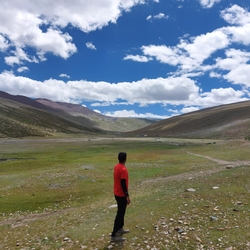While having excellent fitness and proper technical training are a must for a successful mountaineering expedition, it is also important to ensure that you are well equipped with all essential gear that will make your experience more comfortable and enjoyable. This includes both mountaineering and camping gear, without which your expedition would be impossible. These gears aid your climbing on different terrains that you might encounter during the expedition and also ensure your safety and well-being. This makes them an indispensable element of the expedition and it is essential that you don’t leave any of them behind!
The kind of equipment required for an expedition usually depends on the route you are climbing. For example, if you are climbing a route that involves crossing glaciers, then you will need rope and harness among other things. But on routes that are not glaciated, you can leave some of these gears behind. Although experience will teach you what gear you will need for different mountaineering expeditions, this article is a quick guide on the various kinds of climbing gear and their uses.
Gears can be largely classified into personal and common gear. Personal gear includes ice axes, crampons, snow boots, sunglasses, sleeping bags, head lamps etc. Equipment such as tents, snow bars, ration, butane etc. would come under common gear.
PERSONAL GEAR
This is generally referred to gear that you wear or use for yourself. Each climber has a set of these which aid their own climb and protect them from the risk of an injury. These are not shared between climbers as they are all needed by each person at all times during the climb.
Ice Axe: An ice axe consists of a pointy shaft at the base along with a pick and blade at the head. It aids in ascending and descending routes covered in ice and snow, belays, self-arrest, step-cutting and balance among other actions that might be required during technical climbing.
Harness: There are two kinds of harness. One is a full body harness and the other is a seat harness. Harness makes technical climbing and rappelling more comfortable as it is designed to distribute the fall over a larger proportion of the body, thus protecting the climber from potential injuries.
Crampons: Crampons are metallic devices that are spiked at the bottom and are attached to the climbing boots to provide a firm footing on snow slopes and ice.
Helmet: Like most helmets, the ones used in mountaineering protect a climber’s head. The helmet consists of an outer shell, vent holes and adjustable straps for proper fit. They help prevent injuries from falling stones, rocks, ice and also from sudden impact against a rock or from falling.
Carabiners: There are two types of carabiners, screw type carabiner and plain carabiner. Carabiner is the most multifaceted mountaineering equipment available to a climber. Although simple, this piece of equipment offers a critical connection between the climber, their rope and the protection that is attaching them to the mountain.
Tape Sling: Simple but useful, these slings or runners are made from cord or tubular webbing. They create a crucial link between the climber, their rope, the anchors and carabiners.
Snow Boots: These are made of a plastic shell and inner insulating boot. They are used for climbing on snow, ice and other technical terrain, with or without crampons.
Sunglasses: Sunglasses form an important part of the personal gear. They prevent light from getting in from around the lenses by using side shields which protects your eyes and even a third of your face in extreme climates.

Jumar: This piece of equipment enables a climber to climb up the fixed rope. It also arrests the fall of a climber and allows unidirectional movement.
Descender: Also used as a belay device, descender offers a controlled descent on a rope.
Rope: Covered in a woven sheath of nylon, climbing ropes consist of braided nylon filaments at the core. They have a stretch percentage of 6-8% and are also known as dynamic rope. Dynamic ropes protect climbers from injuries in case of a fall. Ropes are key mountaineering equipment as they aid the climb and also secure the climber.
Gaiters: Gaiters are a piece of protective clothing for the climber’s calves and ankles. They stop debris or cold breeze from affecting the climber’s feet from the gap between the trousers and the boots.
Head Lamp: This is a source of light affixed to the head of the climber to aid climbing in dark conditions or to perform various tasks and activities at the camp sites.
Sleeping Bag: This is an insulated covering for a climber that protects them from the cold at nights. It can be closed with a zipper and offers much needed warmth in harsh climate conditions.
Mattress: This is a lightweight sleeping pad that adds comfort while sleeping in tents in high altitude or uneven surfaces.

COMMAN GEAR
Common gear refers to the gear that is shared amongst all the climbers in the group. They are used by everyone equally and are common property.
Butane: This vaporous gas is a fuel source and is stored under pressure in canisters to cook food and heat up water during expeditions. It is one of the most important gears as hot food would be impossible without it!
Tents: Tents used in mountaineering expeditions are specially crafted to withstand extreme weather situations like heavy snowfall, strong winds and low temperatures. These provide shelter during the expedition where climbers can rest and also take cover.
Pitons: A piton is made of malleable steel or other alloys and acts as a secure anchor for ropes attached by a carabiner. These are hammered into cracks in the rock.
Snow Bar: Snow Bars are ice anchors that are hammered into the snow easily and have holes drilled into them for attaching carabiners. It holds the rope in place and acts as a supportive device by securing the weight support of the climber or static loads.
Ration: Most important for a climber’s sustenance during expeditions would be adequate ration. This usually includes lightweight and dried food, instant products and high energy foods.
Deadman Anchor: These are objects that are buried in the snow and act as an anchor for the attached rope.
Snow Shovel: These shovels typically have a flat and rounded bottom and are used to remove snow and ice. They are used for step cutting, clearing obstacles and avalanche rescue among other things. Snow Shovels are usually made in such a way so as to allow them to be folded and made compact when not in use.
Rope: Also known as static rope and having a stretch percentage of 2-3%, these are more rough and have higher resistance to wear and tear. It is used in fixed lines and is designed to have steady and strong holds.

Conducting and also participating in a mountaineering expedition is a herculean task given the logistics and checklists involved! But you will know it was all worth it when you summit that mountain and realise it would not have been possible without these wonderful gears that supported you as much as your team did. While there are other gears that are involved in expeditions depending on the route and terrain, we hope the basic list above gives you an idea of mountaineering equipment that you might need. Should you still have any queries regarding your expedition or what gears you will need, feel free to contact us and we will be happy to clarify!






